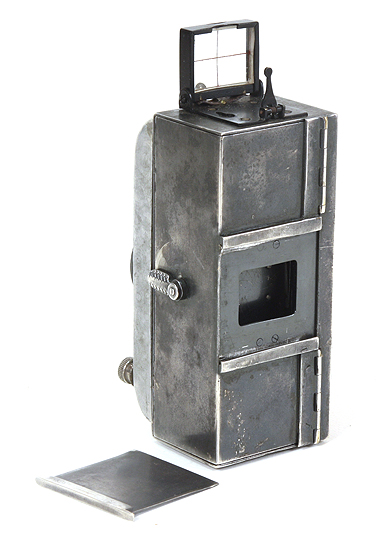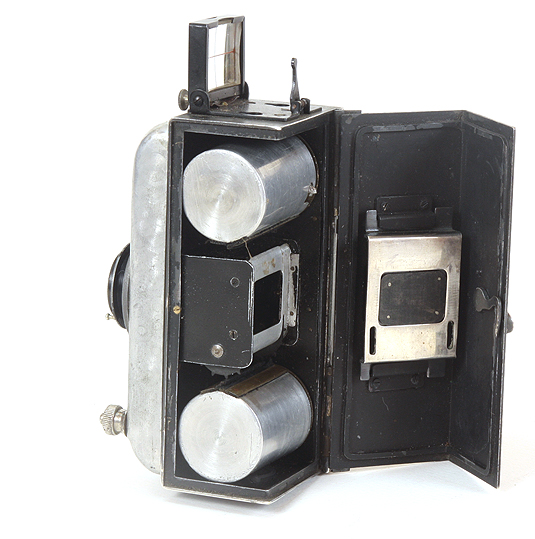|
Mollier Cent vues |
Manufactured or assembled in France from 1910 to (Circa) 1933.
Index of rarity in France: Rare (among non-specialized garage sales)
Inventory number: 20701
See the complete technical specifications
Chronology of cameras Mollier
Traduction de Daniel C.
The name of this camera "Cent Vues" (which means one hundred pictures in French) comes from the maximum number of 18x24 mm pictures (with a 20 mm step) that may be taken using a 2 meters long 35 mm rollfilm contained in the cartridges of the camera.
But the Cent Vues could also be used for positives projection. for enlarging and (as per description in the user's manual) as an instrument allowing for contact type positive to negative inversion.
The rear of the camera shows a window normally closed by a sliding plate that could be removed and replaced by an optical accessory containing a low voltage filament lamp. The film pressing guide must then be replaced by a diffusion screen. The camera, in this configuration could be used as a projector of the positive images of the 35 mm film.
The manufacturer also proposed a supporting frame to convert the camera into an enlarger or a system for copying positive documents or a projector.
The item shown on this page should be a model dated 1927. It is entirely made of metal with a mat front surface. It is fitted with a Galileo type viewfinder and with an helical mount lens Lynx Hermagis f 40 mm. The camera bears the number 698 (ou 869 ?) engraved near the tripod threaded socket.
It weighs about 650 grams and shows small dimensions (13 x 5,5 x 7 cm). The indicator showing the number of taken pictures goes up to 99!
In August 1927 its price was 950 FF, the leather bag 60 FF, The film cartridges 27,50 FF per unit and the projectors lamp package 126FF.
You had to pay 11 FF for one film processing and 10 FF for copying a positive.



Etienne Mollier (1876-1962), a self-taught mechanic, dedicated his life to developing his inventions as well as those of other creators (as documented in "Mémoires d’un inventeur," Etienne Mollier, Editions L’Harmattan).
After inventing a focal plane shutter in 1902, which was rejected by Krauss and later taken up by Gaumont, Etienne Mollier designed a small pocket-sized camera called "Le Colibri" with a format of 4.5 x 6 cm. The aim was to provide French competition to the early roll-film Pocket Kodaks. Despite its pocket-sized design, it did not achieve the expected success. While continuing to manufacture more conventional cameras, Etienne Mollier diversified by building prototypes for other inventors, some of which went on to thrive while others were forgotten.
In 1905, he began working in the field of cinema. Among his personal inventions, we can mention:
- "L'Autodévolteur," which allowed the adaptation of light for projecting a still image from a film. This device was used by Pathé with the Pathé-Baby home projector.
- In 1924, the "Ciné-Type," the first camera to use a reduced film size by cutting a standard-sized film (35 mm) in half.
- In 1926, the "Ciné-business valise," a portable film projector.
After his company was acquired by Demaria-Lapierre in 1929, he became interested in using images for education and actively promoted the small 24 x 36 mm format. He developed devices for projecting opaque or transparent documents, cinema projectors, and even advertising ("Grapholux"). In 1937, he built the "Opascope horizontal," the first daylight retroprojector.
His photographic and cinematographic activities were connected to other famous pioneers such as Demaria, Lapierre, Mendel, Jougla, Joly, Bancarel, Lumière, Chrétien, and more. In 1910, he was awarded the Gold Medal at the Concours Lépine for "Le Cent Vues," the first mass-market camera using 35 mm cinema film.
Like the "Colibri," the small format challenged the principles of photographers of the time, and it remained relatively obscure until the outbreak of World War I in 1914. Upon its revival in 1920, thanks to Mollier's persistence, this camera was finally recognized and used, primarily in technical or educational applications rather than among the general public. For example, it played a crucial role in an automatic system for photographically recording pulse counters in French telephone exchanges.
Interesting links or bibliography :
Add a link or element of bibliography, a picture taken with this camera, a picture of box or an ads about this camera
Your photos taken with the same camera:
Cameras from Ebay France (Mollier) (Uploaded each 3 hours)








